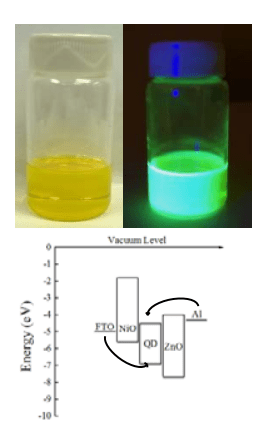All Inorganic Colloidal Quantum Dot LED with Metal Oxide Charge Transport Layers
Student: Haider Salman
Degree: M.S., December 2015
Major Professor: Dr. Omar Manasreh
Research Area(s):
Nanoscience & Engineering
Background/Relevance
- Highly efficient quantum dots LED have promising applications in display technology due to narrow emission and tunable color.
- Research is being conducted to investigate the mechanism of these devices since their physics is not yet understood.
Innovation
- Low cost advantage of the solution processed layers deposited by spin coating compared with the organic material LEDs.
- Synthesis of colloidal quantum dots can result in much higher monodispersed colloid than those obtained by epitaxial growth.
- Choosing the materials of the layers that form the device is a key principle in the device fabrication.
Approach
- Use sol-gel procedure to synthesize the solution processed layers of the LED.
- Deposit the LED layers on ITO slides using spin coater.
- CdSe/ZnS, ZnO, and NiO are used as the emissive, electron, and hole injection layer, respectively.
- MoO3 was also prepared as an alternative hole transport layer.
- Deposit 100 nm aluminum cathode using ebeam am evaporator

Key Results
- Synthesized materials were characterized using PL, absorbance, and Raman Spectroscopy. XRD and XPS were used to investigate the crystallinity of the deposited thin films.
- I-V characteristics of the device showed a turn-on voltage at 4 V and a maximum current density at 9 V.
- NiO carrier concentration was investigated by fabricating Schottky diode made of Al and NiO thin film.

Conclusions
- Using NiO as the P-type HTL represents a good option due to its electrochemical stability, low cost, and easy synthesis procedure.
- The obtained efficiency is still low and the device turn-on voltage is still high.
Future Work
- More research is required to increase the efficiency and lower the turn-on voltage of the device.
- More investigation to understand the physics of the device working principles especially the role of Auger recombination and Forster resonance.
